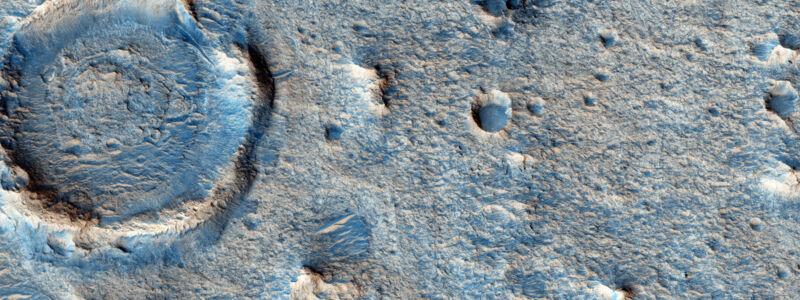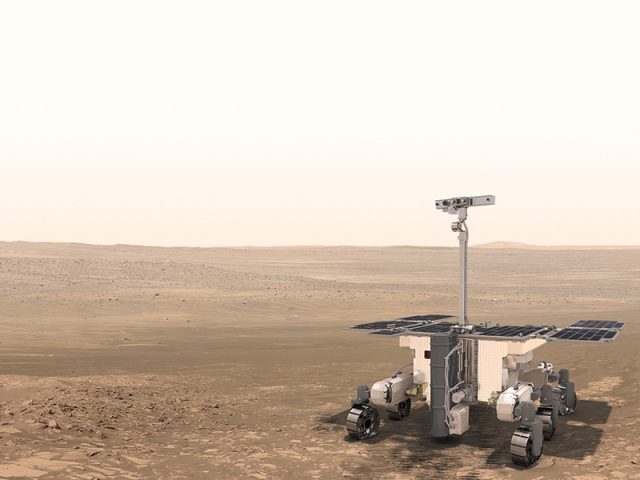
NASA/JPL/Cal Tech
March 17, 2022, was a rough day for Jorge Vago. A planetary physicist, Vago heads science for part of the European Space Agency’s ExoMars program. His team was mere months from launching Europe’s first Mars rover—a goal they had been working toward for nearly two decades. But on that day, ESA suspended ties with Russia’s space agency over the invasion of Ukraine. The launch had been planned for Kazakhstan’s Baikonur Cosmodrome, which is leased to Russia.
“They told us we had to call the whole thing off,” Vago says. “We were all grieving.”
It was a painful setback for the beleaguered Rosalind Franklin rover, originally approved in 2005. Budget woes, partner switches, technical issues and the COVID-19 pandemic had all, in turn, caused previous delays. And now, a war. “I’ve spent most of my career trying to get this thing off the ground,” Vago says. Complicating things further, the mission included a Russian-made lander and instruments, which the member states of ESA would need funding to replace. They considered many options, including simply putting the unused rover in a museum. But then, in November, came a lifeline, when European research ministers pledged 360 million euros to cover mission expenses, including replacing Russian components.
When the rover finally does, hopefully, blast off in 2028, it will carry a suite of advanced instruments—but one in particular could make a huge scientific impact. Designed to analyze any carbon-containing material found underneath Mars’s surface, the rover’s next-generation mass spectrometer is the linchpin of a strategy to finally answer the most burning question about the Red Planet: Is there evidence of past or present life?
“There are a lot of different ways that you can search for life,” says analytical chemist Marshall Seaton, a NASA postdoctoral program fellow at the Jet Propulsion Laboratory and coauthor of a paper on planetary analysis in the Annual Review of Analytical Chemistry. Perhaps the most obvious and direct route is simply looking for fossilized microbes. But nonliving chemistry can create deceptively lifelike structures. Instead, the mass spectrometer will help scientists look for molecular patterns that are unlikely to be formed in the absence of living biology.
Hunting for the patterns of life, instead of structures or specific molecules, has an added benefit in an extraterrestrial environment, Seaton says. “It allows us to not only look for life as we know it, but for life as we don’t know it.”

ESA/ATG MediaLab
Packing for Mars
At NASA’s Goddard Space Flight Center outside Washington, DC, planetary scientist William Brinckerhoff shows off a prototype of the rover’s mass spectrometer, known as the Mars Organic Molecule Analyzer, or MOMA. Roughly the size of a carry-on suitcase, the instrument is a labyrinth of wires and metal. “It’s really a workhorse,” Brinkerhoff says as his colleague, planetary scientist Xiang Li, adjusts screws on the prototype before demonstrating a carousel that holds samples.
This working prototype is used to analyze organic molecules in Mars-like soils on Earth. And once the real MOMA gets to Mars, approximately in 2030, Brinckerhoff and his colleagues will use the prototype—as well as a pristine copy kept in a Mars-like environment at NASA — to test tweaks to experimental protocols, troubleshoot issues that come up during the mission and facilitate interpretation of Mars data.
This latest mass spectrometer can trace its roots back nearly 50 years, to the first mission that studied Martian soil. For the twin 1976 Viking landers, engineers miniaturized room-size mass spectrometers to roughly the footprint of today’s desktop printers. The instruments were also on board the 2008 Phoenix lander, the 2012 Curiosity rover and later Mars orbiters from China, India, and the US.
Anyone visiting Brinckerhoff’s prototype must first pass a display case with a dismantled copy of the Viking instrument on loan from the Smithsonian Institution. “This is like a national treasure,” Brinckerhoff says, enthusiastically pointing out components.
Mass spectrometers are indispensable tools that are used for analytical chemistry in laboratories and other facilities worldwide. TSA agents use them to test luggage for explosives at the airport. EPA scientists use them to test drinking water for contaminants. And drugmakers use them to determine chemical structures of potential new medications.
Many kinds of mass spectrometers exist, but each “is a three-part instrument,” explains Devin Swiner, an analytical chemist at the pharmaceutical company Merck. First, the instrument vaporizes molecules into the gas phase, and also gives them an electrical charge. These charged, or ionized, gas molecules can then be manipulated with electric or magnetic fields so they’ll move through the instrument.
Second, the instrument sorts ions by a measurement that scientists can relate to molecular weight, so they can determine the number and type of atoms a molecule contains. Third, the instrument records all the “weights” in a sample along with their relative abundance.
With MOMA aboard, the Rosalind Franklin rover will land at a Martian site that roughly 4 billion years ago likely had water, a crucial ingredient for ancient life. The rover’s cameras and other instruments will help to select samples and provide context about their environment. A drill will retrieve ancient samples from as deep as two meters. Scientists hypothesize that’s far enough, Vago says, to be shielded from cosmic radiation on Mars that breaks up molecules “like a million little knives.”
Space-bound mass spectrometers must be rugged and lightweight. A mass spectrometer with MOMA’s capabilities would normally occupy multiple workbenches, but it’s been shrunk substantially. “To be able to take something that can be as big as a room to the size of like a toaster or a small suitcase and send it into space is a very huge deal,” Swiner says.








